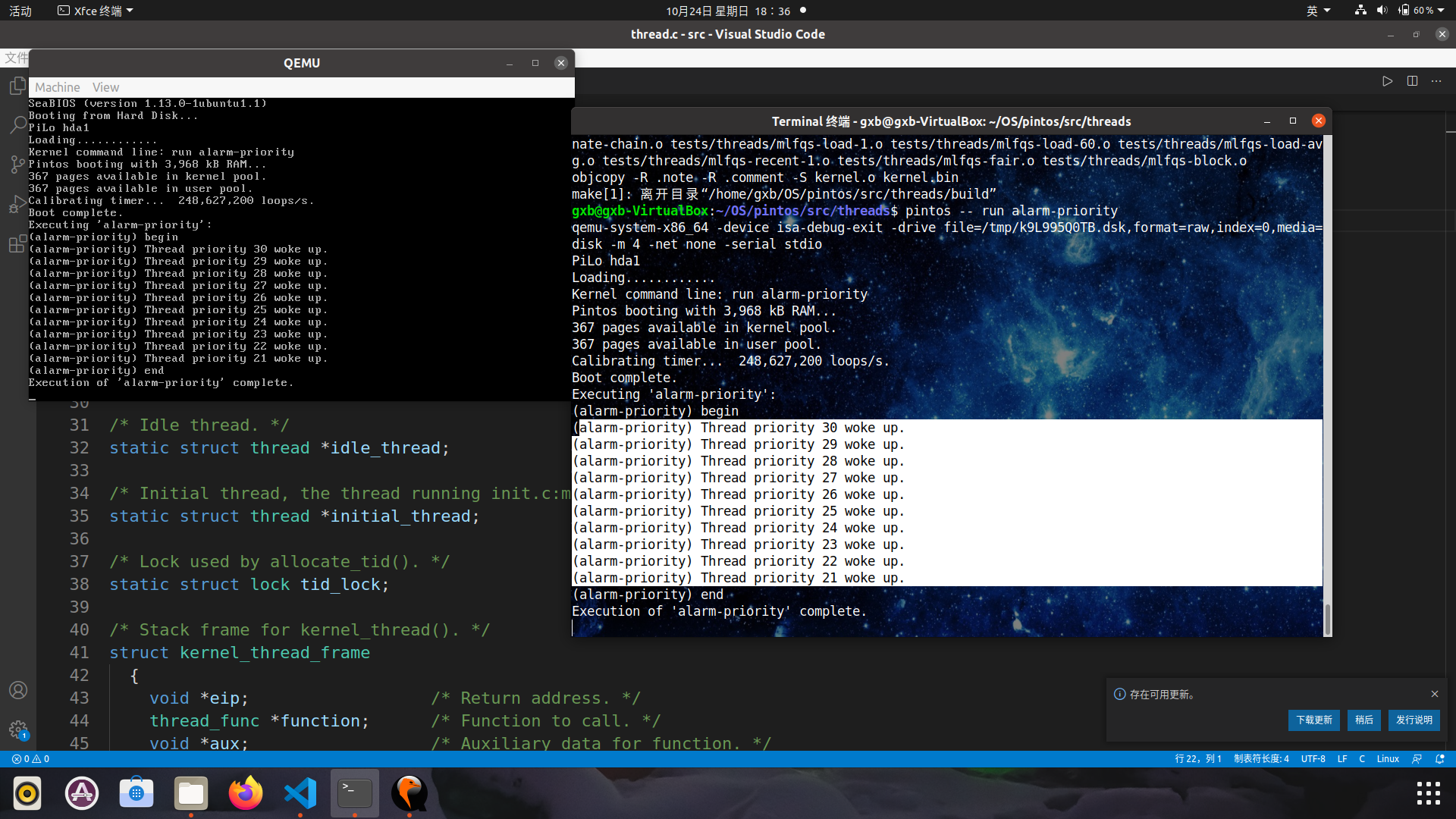@SovietPower
2021-12-06T08:23:46.000000Z
字数 5290
阅读 2063
OS 实验3 实现优先级调度
OS
背景
第一个项目在src/threads中。pintos的各项目之间是独立的,不会互相影响。
该实验中需做到Project 1中优先级调度的基本实现,即(只需)将原本的FIFS调度改为优先级调度。
测试方法:
在thread文件夹中使用make,可生成build目录;使用make clean,可清空之前编译生成的结果,以进行新的测试;使用命令make check可生成build并测试当前的threads是否能通过所有测试(非常非常慢,可能是qemu的问题)。
make完后,使用命令pintos -- run alarm-priority可运行alarm-priority的单个测试,其它测试同理。
make check是pintos自带的测试对比工具,会将当前threads中代码的运行结果与预期结果进行比对,以测试当前代码正确性。
在修改threads前,不能通过20/27个测试点。Project 1的目标为通过所有测试点。
make check的测试方式在src/tests/threads/Make.tests中定义,可增加或减少测试参数,自定义或简化测试(修改文件开始tests/threads_TESTS中的内容)。
若不使用make check,即使用pintos -- run <test>自己测试,需自行将输出结果与预期结果进行比对。
每个test的预期结果保存在对应的.ck中。如:alarm-priority.ck中保存了test_alarm_priority的预期结果。
注意,要修改的是配置pintos时指定的路径那里的pintos文件。使用pintos命令时,会运行那个路径下对应的目录里的build,而不是当前目前下的build。所以make和文件修改都应在那个目录下进行。
每次修改完代码后,要重新make(可能还要先make clean),再pintos -- run才能看到更新后的结果。
在src/threads/init.c中定义了所有pintos测试的入口。
运行pintos测试会执行run_actions(argv),然后调用run_test(argv[1])执行argv[1]指定的task:run_test(task)会调用与task对应的测试函数,具体可见src/tests/threads/tests.c。
本实验中则使用测试函数test_alarm_priority(),位于src/threads/alarm-priority.c。
pintos部分代码
src/lib/debug.h中有若干宏定义:
/* GCC lets us add "attributes" to functions, functionparameters, etc. to indicate their properties.See the GCC manual for details. */#define UNUSED __attribute__ ((unused))#define NO_RETURN __attribute__ ((noreturn))#define NO_INLINE __attribute__ ((noinline))#define PRINTF_FORMAT(FMT, FIRST) __attribute__ ((format (printf, FMT, FIRST)))
使用这些宏,可实现代码注释,以显著表现一个函数或参数的特性。
如在任意位置加入UNUSED,表明该位置的函数或参数未被使用。
线程优先级调度实现
测试函数test_alarm_priority()及相关定义
PRI_MIN, PRI_MAX, PRI_DEFAULT
优先级的最小值、最大值、默认值。为。
#define PRI_MIN 0 /* Lowest priority. */#define PRI_DEFAULT 31 /* Default priority. */#define PRI_MAX 63 /* Highest priority. */
semaphore
信号量。信号量为非负整数,当为正时表示资源可用,为0时表示资源不可用。
除初始化外,信号量只能由两个原子操作控制:
sema_down或P:等待信号量变为正,然后减少信号量,即等待一个被分配资源。
sema_up或V:增加信号量,即增加一个可用资源(若有等待线程则唤醒一个)。
sema_init()
将信号量初始化为给定非负整数。
void sema_init (struct semaphore *sema, unsigned value);
test_alarm_priority()
创建10个线程,优先级分别为。
这10个线程会在5秒后同时执行、同时竞争CPU。每个线程执行完毕后会输出它的名称。
该函数会等待所有线程执行完毕。
void test_alarm_priority (void)
thread_create()
创建一个内核线程,其名称为name,优先级为priority,需要执行函数function,需要的参数为aux。
如果创建成功,返回其tid;否则返回TID_ERROR。
tid_t thread_create (const char *name, int priority, thread_func *function, void *aux)
thread_mlfqs
bool变量。若为true,表示使用多级反馈队列调度(multi-level feedback queue scheduler);否则使用轮询调度(round-robin scheduler)。
通过加入命令行参数-o mlfqs启用。
TIMER_FREQ
计时器每秒的中断次数(计时次数)。为,即每10ms次中断/tick一次。
#define TIMER_FREQ 100
timer_elapsed()
返回给定时刻距现在经过了多少次计时(tick)。
int64_t timer_elapsed (int64_t then){return timer_ticks () - then;}
timer_ticks()
返回自系统启动以来计时器计时(tick)了多少次。
int64_t timer_ticks (void);
调度函数及相关定义
调度函数为schedule(),位于thread.c。
list_entry()
将指向列表元素的指针转为给定结构体指针(比如struct thread)。
#define list_entry(LIST_ELEM, STRUCT, MEMBER) \((STRUCT *) ((uint8_t *) &(LIST_ELEM)->next \- offsetof (STRUCT, MEMBER.next)))
next_thread_to_run()
从就绪队列中选择并返回下一个要调度运行的线程。若就绪队列为空,返回idle_thread。
static struct thread *next_thread_to_run (void){if (list_empty (&ready_list))return idle_thread;elsereturn list_entry (list_pop_front (&ready_list), struct thread, elem);}
running_thread()
返回当前正在运行的线程。
类似的函数是thread_current(),为running_thread()加上线程合法性检查。
struct thread *running_thread (void);struct thread *thread_current (void);
schedule()
寻找一个新的可切换进程,并切换。
中断必须关闭。
在该函数运行完成前(即thread_schedule_tail()运行完成前),不应调用printf()。
static void schedule (void){struct thread *cur = running_thread ();struct thread *next = next_thread_to_run ();struct thread *prev = NULL;ASSERT (intr_get_level () == INTR_OFF);ASSERT (cur->status != THREAD_RUNNING);ASSERT (is_thread (next));if (cur != next)prev = switch_threads (cur, next);thread_schedule_tail (prev);}
switch_threads()
进程切换函数。switch.c中无该函数的源码,在switch.S中有。
将当前进程从cur切换到next:保存next的上下文,切换到cur的上下文。
cur必须是当前正在运行的线程,next必须正在运行该函数。
struct thread *switch_threads (struct thread *cur, struct thread *next);
thread_schedule_tail()
激活新线程的页表,以完成新线程切换。若之前的进程处于THREAD_DYING状态,释放它的页表结构。
在该函数运行完毕后,表示schedule()运行完毕,此时新线程已经开始运行,中断依旧处于关闭状态。
void thread_schedule_tail (struct thread *prev);
FIFS调度
在函数next_thread_to_run()中,可以看到pintos如何调度:
static struct thread *next_thread_to_run (void){if (list_empty (&ready_list))return idle_thread;elsereturn list_entry (list_pop_front (&ready_list), struct thread, elem);}
即在就绪队列非空时,选择就绪队列ready_list的队首。
在thread.c中,需要加入线程到就绪队列的函数有:thread_unblock(), init_thread(), thread_yield()。
而所有使用的操作是list_push_back (&ready_list, &cur->elem),即直接加入到队列尾。
所以先产生、先进入队列的线程,最先被调度(通过list_pop_front),即pintos使用的FIFS。
优先级调度
list.c中包含了:在列表指定位置插入元素的list_insert();根据指定优先级比较函数less,在列表的合适位置(按less排序)插入指定元素的list_insert_ordered()。
所以,若要将FIFS调度改为优先级调度,只需实现以下操作,以保证优先级更高的线程位于就绪队列的更前面。
因为目前线程优先级不会改变,所以只需实现加入线程到队列时,优先级更高的线程位于就绪队列的更前面。
1. 声明一个优先级比较函数compare_by_priority(),根据priority进行比较,使less (elem, e, aux)在elem优先级高于e时为真。
该函数的比较元素为struct list_elem *,若需作为线程使用,需使用list_entry(x, struct thread, elem)转为struct thread *。
bool cmp_thread_priority(const struct list_elem *x, const struct list_elem *y, void *aux){return list_entry(x, struct thread, elem)->priority > list_entry(y, struct thread, elem);}
2. 将加入线程到就绪队列的所有操作,从list_push_back (&list, elem)改为list_insert_ordered (&list, elem, (list_less_func *) &cmp_thread_priority, NULL)。
共需修改三个函数thread_unblock(), init_thread(), thread_yield()。
测试结果:

